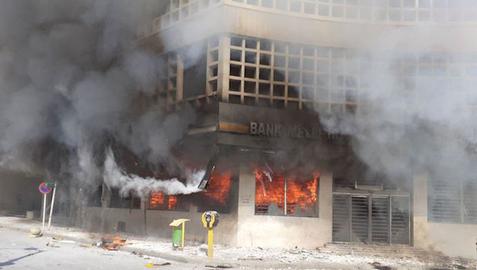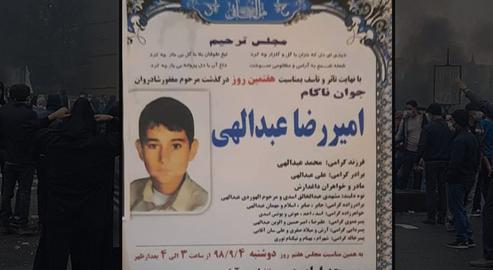This is Behbahan, a seemingly peaceful city full of heartbroken people.
In every main square in the city, there’s a building damaged by fire. The fences separating the sidewalks and the streets are intertwined, the Qavamin Bank at the south side of Dokhtar Square is completely burnt down, and Helal-e Ahmar Square, Steel Square, Marahel Square, and Shiraz Square all bear the wounds from recent events.
A high school history teacher and resident of Behbahan called Fariba told IranWire: "The destroyed walls and burnt-down buildings are not all that matters; what you feel most strongly is the sadness over the body of the city. People are sunk into themselves. It is as if they feel there is no hope."
She says people are sad and desperate: "The government is not willing to give up its power peacefully, and police suppress each public protest 10 times more brutally than they did the time before; people really do not know how to manage this amount of oppression and pressure."
Fariba says last week, the streets of Behbahan were home to a series of spontaneous, ferocious battles, and protesters repeatedly clashed with police.
Fariba first came across the clashes early in the morning of November 16, when she went to the cash machine at Refah Bank.
"I got there and people were throwing rocks at the bank's windows," she says. "A big strong man wearing a dark blue suit picked up a stone. Suddenly he saw a bank employee through the window who had found shelter behind some tables. The man stopped people [from throwing rocks] and told them a fellow citizen was still inside the bank. The people were excited and hard to get under control, but they managed to wait until the bank employee left before attacking it. The security forces were standing around, doing nothing to drive the people away.”
But what really made people upset was the shooting of a teenage girl in a schoolyard.
"A high school girl was shot and killed in the middle of the Ghazal Mousavi schoolyard. Nobody knows how this 17-year-old girl was shot. Why was she there at that time of day? How did the bullets go through the school walls and hit her?"
Fariba says there was no official announcement about school closures, but school officials had contacted parents to tell them that it was best not to bring their children to school for their own safety. Schools have been up and running since November 22, she said, but some families still do not feel it is safe to send their children to classes. Understandably, the schools are not being very strict about students' presence.
Full Hospitals and Widespread Brutality
Although Behbahan is a small city with a modest population, Fariba said there had been traffic jams during the days of protests. According to her, even though the situation has calmed down, security agents remain on the streets and disperse any groups of three or more people.
Fariba says in one clash she witnessed, security forces threw rocks at people first, and the people responded. The difference was that the agents had shields, helmets and defense equipment and so were protected, but some protesters were seriously injured. The hospitals were full of people with head and shoulder injuries, and many of them had to sleep in the hospital corridors.
One dusk when she was returning after being back at work teaching, Fariba saw a woman she said was close to 70 years old sitting on the side of the City of Night shopping center entrance with blood pouring from her head. "She was sitting on the ground with her wounded face and wearing a shawl. There was blood all over the ground. Her head had been wounded from a blow from a baton. She said she had not come to any of the protests, but that she had wanted to visit her daughter, who is in her last month of pregnancy. But when she was on her way from the nearby park to the City of Night shopping center, somebody on a motorcycle had attacked her with a baton from behind.” Fariba said the woman had told her that her attacker didn’t even see who she was and just came out of the alley and attacked the first person he saw.
“I tied her head with a piece of her veil and gave her some water and grabbed her by the hand, crossing the alleyway to get out of danger and take her to her daughter's house, But her head needed stitches and serious treatment. When the old woman was walking away, I thought: how long will it take for the 70-year-old woman's wounds to heal?"
Ms Naraqi is a nurse at Shahidzadeh Hospital. She was at a wounded young man's bedside on the second day of protests, and had spoken a few words to him. He died a few minutes later from severe bleeding.
"That young man was still awake, but he had lost a lot of blood and they were preparing the operating room for him. I held his hand. He said to tell his mom. I went to help with the operating room equipment, but when I came back they said he died and the guards took his body. I don't know where.” She said she wasn’t sure how many had died in the hospital after injuries sustained at protests, but found it hard to believe the official estimate of eight, based on what she had observed.
The Dead, the Missing, the Detained
The nurse says many people came to the hospital and announced that their child had left the house and had not come back. "We put the names of the wounded on the notice board at the hospital entrance. There were people who went to the Social Security Hospital and other medical centers in the city looking for their loved ones, but their names had not been registered anywhere."
"As I heard, six people were buried under tight security, and it was emphasized that no one had the right to be present at the funeral of these six people. I don't think anyone in the city of Behbahan was asked to pay any money for the delivery of the body of their beloved, but I know some families [elsewhere] were told to give between 40 million and two hundred million tomans [$3,300 to $16,650]. Detainees were also told to call their families to bring money in order to get them released. They told a young man that they had to raise money to pay for the repair of damage done to the banks. They want to increase the pressure with these threats so that no one dares to do this again."
Salar lives near Ebn-e Sina Square. He says all three gas stations in the city are now out of order, and one of his neighbors had gone to the village of Jaizon to get gas, but that when he crossed the road with his canister, a car hit him, and he was lying on the side of the road for hours before eventually dying due to blood loss.
He says everyone he has talked to in the city said they had gone out to protests unarmed, but they still faced attacks from the police and security forces.
"The Behbahanese are very peaceful and calm people. There is no culture of gun possession in the city. The residents of the suburbs, who are predominantly from Lor tribes, may have weapons due to the necessities of living a nomadic life and hunting, or for weddings and celebrations, but basically such things are not common among the people. There were rumors about gunshots and that the law enforcement guards were injured, and this escalated the situation and led to the deployment of special anti-riot units in the city, but that cannot be true because the people were not armed. Many of the dead are young people who are not militants, or those who have taken to the streets to watch."
Salar says the amount of violence and the clashes across the city have given way to heated and dramatic rumors. "Scary things are said. All the dead are said to have been shot in the head directly or in the throat, and that there are trained Syrian and Iraqi snipers on the scene. Whether that's true or rumored, it is scary to hear."
Salar says it’s frustrating that authorities have made no attempt to talk to the city’s ordinary people.
"No one came to talk to the people. Instead they came with batons to hit whoever was sitting quietly in the middle of Melli Bank Square and chanting [protest slogans]. Instead of trying to placate, they were threatening. That is why the clashes escalated and the distance between Melli Bank Square and Shiraz Square practically became a battle scene."
Saleh says the situation in the city has been calm since Friday, November 22, but people in the city are worried about the arrests and their consequences. "They say the number of detainees has exceeded the capacity of the prisons and some have been transferred to Sheyban Prison in Ahvaz. It appears that many people have been identified via surveillance cameras at government buildings. There are rumors that they have quietly executed several people involved in setting fire to the banks. The news has not been confirmed, but it has had a profound effect on people's morale, and it is not possible to get accurate news because many still do not have the internet."
visit the accountability section
In this section of Iran Wire, you can contact the officials and launch your campaign for various problems


























comments